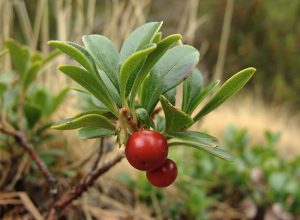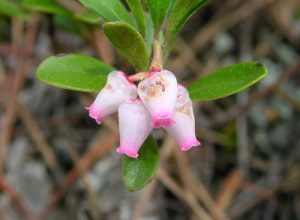Ursi Grape – Arcotostaphylos Uva Ursi


Present in the hills and the mountains areas of the Northern Hemisphere of our continent, originally from northern Europe and North America, it belongs to the ericaceae family which includes one hundred genre of almost 3500 species, of which our fragile Erica and this last mentioned has relavant healthy affinity to the Ursi Grape.
A small shrub with prostrate branches, which can reach a length of a metre, from which the shoots grow vertically up to 20/30 cms. It is an evergreen which has meaty, shiny dark green leaves the upper layer is slightly bronze in comparison to the lower layer, the plant renews itself every three years; in particularly cold Winters and drought they take on a red brown colour.
Very resistant to cold you can find them in the wild on the hills above 500 metres and up to and beyond 2000 metres, they grow well in the sun; preferably near rocks or stones which allows the roots to benefit the damp which is always just below.
TERRAIN
As with the majority of the ericaceae, the Ursi Grape also needs an exclusively acid soil, which has a ph not superior to; 5.5 soil with a calcium content even that of a modest percentage (10/15%) favours the formation of calcifero which, briefly saying, impedes chloro photosynthesis killing the plant.
Because of the perculiar process of autofissazione (see goumi del Japan), they can develop even in poor soil, but prefer a fresh soil rich in humus, not necessarily very deep, but without stagnant water. If want to pot the the plant, we should only use acid top soil.
FLORA AND FRUIT
In Spring, depending also on altitude, once it is no longer icy, the Ursi Grape produces small vine (racemes) made up of 4 / bell shaped flowers, typical of the family, white with pink tips, somewhat spotted, as with most of the plants which grom in the wild, The flowers are self-pollinating.
With the arrival of the heat beautiful bright red, round berries appear, very pleasant to see mixed together with the shiny green of the leaves. The berries, even though edible, because of high levels of tannin, do not have excellent organoleptic quality.
USE ANDHEALTH PROPERTIES
If the climatic and/or the characteristics of the soil permit, the plant is best considered ornamental to adorn a rock garden.
It is the leaves which make this small shrub unique, it contains a composition of phenolics which have a high number of products derived from chemical and physical reactions which take place in an organism.
These are mainly made up of arbutine , through which a complex process of transformation takes place in our body, they are expelled, passing through the kidneys via the urine, the properties of arbutine and the other compounds, mixed with organic liquid is expelled during urination causing the walls to conduct an important antiseptic action, it is curative and preventative in cystitis, it copes where even pharmaceutical antibiotics fail. It has revitalizing properties for the liver and kidneys, it aids excretive and diuretic functions and is advised in the treatment of prostatic hyptrophy and leucorrea.
You can use the fresh or dried leaves, in a herbal tea,or for dyeing by adding bi-carbonate to reduce the acidity thus avoiding burns caused by the mint leaves and to improve the taste so you drink a diluted derivative for a few days, in any case not for more than a week. You should pay careful attention to how you use the Ursi Grape: excessive or improper use , such as gastri problems and in the worse case scenarios intoxication, whilst the green colouration of urine is a natural facto at the same time it can be an effect of a compound of the plant.
Taking into consideration the various side effects in the use of this product, derived from the ursi Grape, before following a treatment you should consult a herbalist or your Doctor.
BE WARNED the contents of this text are intended to be purely educational.However Prandini’s Nursery is certain of the reliability of what is here reported, we do not however accept any reponsibilty regarding possible error, forgetfulness, or misinterpretation.
PRUNING AND CULTIVATION
Suddenly finding itself in a natural environment, it doesn’t need human intervention at least only for the pruning and containment of plant pots or rock gardens.
Even disease is somewhat rare: root rot can appear in the case of poor drainage and we have already mentioned: calcifero. In that which is too calcareous. The leaf is enjoyed by the oziorinco, and other parasites. The Ursi Grape plant is not subject to this.
